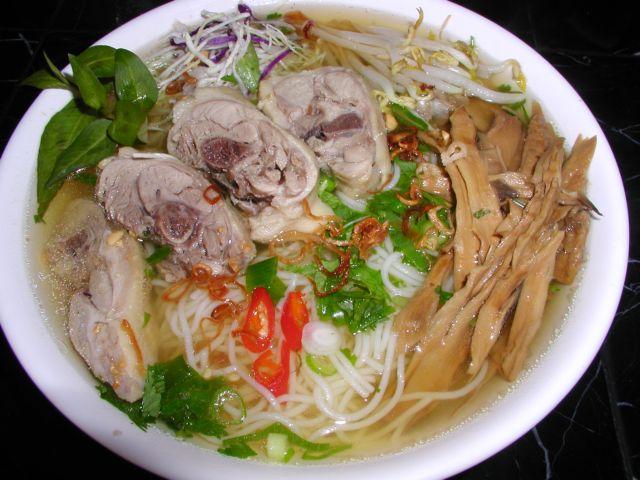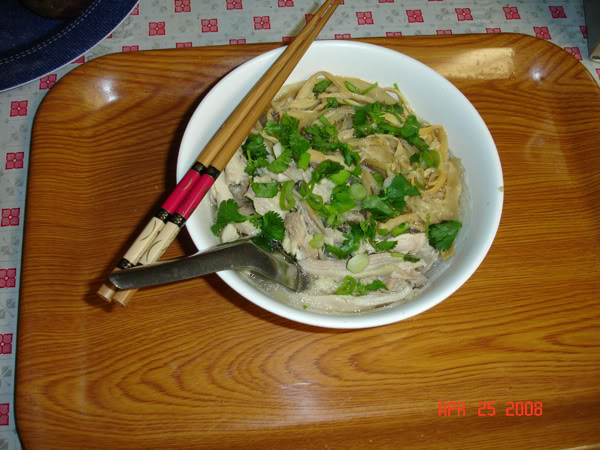Mang kho and mien make up the two most important soups of the traditional Tet feast in north Vietnam. 
Mang kho (dried bamboo shoots) and mien (cassava noodles) are both dried naturally and the drying process preserves them beautifully; you don’t have to worry that your bamboo or cassava will go bad for a long time.
Canh mang kho (dried bamboo shoot soup) and soups made with mien (often chicken noodle soup) both combine dry textures with fresh ingredients and herbs for their unique flavors.
Because mang kho and mien are light and somewhat soft and porous in texture, they absorb the flavors of the other ingredients in the soup: chicken or duck and/or pork, spring onions and moc nhi (black, or “cat ear” mushrooms).
After the war when cooking and money were scarce as Vietnam struggled to recover from the worst bombing campaign in history and then a suffocating American embargo, busy working mothers bought bundles of mang kho and mien in advance before Tet (Lunar New Year Festival) while prices were still cheap before holiday inflation. A northern Vietnamese Tet feast is not complete without these two dishes.
Mang kho and mien can absorb a lot of water and they become about three times larger in volume during the cooking process, another plus for cooks struggling to make ends meet.

Mien is made of cassava powder. Besides various mien-based soups, then noodle is also an important ingredient in nem ran (fried spring roll).
The most traditional mien dish is mien ga (cassava noodle with chicken broth and shredded chicken). The dish is set at the family altar during Tet, and in various arrangements at funerals, death anniversaries and other special occasions.
During Tet, northerners keep the water they boil their chickens in to use for mien ga. Boiled chicken meat, as well as boiled chicken heart, stomach and liver, are shredded and cut into small pieces before being placed in the bowl.
After soaking the dried mien in water until it becomes softer, northern cooks then cut it into shorter pieces and add it to the hot water pot. Moc nhi and spring onion are cut into small pieces and also added to the pot to help bring out the flavor of the chicken.
Mien is very fragile and soft and it takes only a few minutes to cook it. The cook needs to make sure the noodles don’t boil too long in order to maintain the right softness.
After arranging mien in a bowl, my mom would add shredded chicken meat and chicken liver on top together with coriander. The soup looked almost as delicious as it tasted.
Nowadays, people also cook mien with duck and it is served all day long at some Hanoi restaurants. The subtle taste of mien also goes well with crab meat. Mien cua (stir-fried mien with crab meat) is a new dish served across Hanoi.
Fried tofu, and spring onions often accompany mien cua in Hanoi.
During protein-rich meals chock full of pork pie, beef pie, boiled chicken and sticky square cake, mien is a light and delicate dish for people avoiding heavier foods, or those trying to save room for later during daylong Tet feasts. At Tet, mien is often served alone but some people like to have it with a side of steamed rice.
With its ingredients usually cut into very slim and small pieces, mien remains subtle in flavor. But mang kho offers a combination of rawness and softness that is a bit sharper. The shredded dried bamboo shoots are cooked in chicken water for hours, or even boiled in a pot with pork legs and pork ribs.
If you have the chicken water already, it takes only a few minutes to cook mien (which is normally the last dish cooked just before the Tet feast). But it takes hours to cook canh mang kho (dried bamboo sprout soup).
The mang kho is first soaked in water and boiled for hours until it becomes soft. Then it is shredded into smaller pieces by hand before cooking
Similar to mien, mang kho can be cooked with chicken water or pork chops. But it takes many hours to cook, and my mom would always start preparing to cook a big pot of canh mang three days before the Tet feast. Then, with each meal throughout the festival, we’d have a portion of the re-heated soup invigorated with fresh chicken water.
Source:Thanhniennews
|














